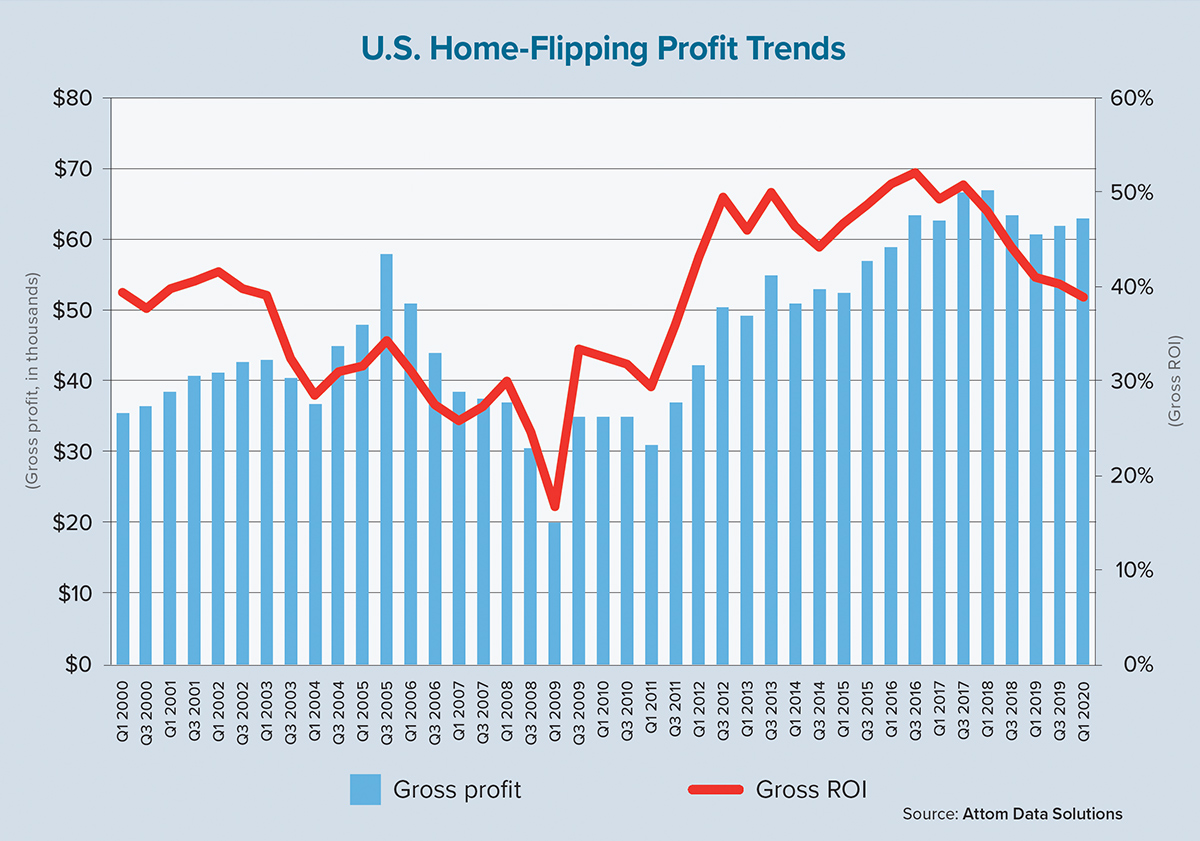As the effects of the global pandemic continue to ripple across every aspect of the real estate market, the share of U.S. home sales involving fix-and-flip projects has declined. Surprisingly, however, profits and profit margins have increased, according to a second-quarter 2020 home-flipping report from Attom Data Solutions.
From April through June of this year, only 6.7% of all U.S. single-family home and condominium sales were flips, down from 7.5% in first-quarter 2020 but up from 6.1% in second-quarter 2019. At the same time, the gross profit margin on the typical home flip increased on both a quarterly and annual basis to $67,902, up from $63,000 in first-quarter 2020 and $61,900 in second-quarter 2019.
These larger gross profits also translated into an increased return on investment (ROI) for the typical flip, with ROI ticking up to 41.3% in second-quarter 2020. That compared favorably to ROIs of 38.9% in the first quarter of this year and 40.4% in the second quarter of last year. This marked the first quarterly jump in ROI since third-quarter 2018 and the first year-over-year gain since fourth-quarter 2017.
Interestingly enough, the effects of the pandemic seem to have hurt nationwide sales of flipped homes. The overall number of purchases declined, although prices increased in several areas of the country as buyers vied for a reduced supply of homes. Sales slowed as potential buyers stayed home to conform to social-distancing requirements and the buyer pool was reduced amid rising unemployment. With interest rates at historic lows, however, buyers who remained employed were attracted to a somewhat competitive market, allowing for profit increases amid decreased supply.
At the local level, however, the figures were a little different. In 114 of the 151 metropolitan statistical areas (MSAs) analyzed in the report, or 75.5%, home flips as a portion of all home sales decreased from the first to second quarters of this year. The largest quarterly declines were in Durham, North Carolina (down 40.7%); Provo, Utah (down 36.6%); Boston (down 35.1%); Denver (down 33.7%); and Salt Lake City (down 32%).
Some areas performed better in second-quarter 2020, however, and saw significant improvements in their shares of home flips. The largest quarterly increases were in Salisbury, Maryland (up 45.8%); Fort Myers, Florida (up 20.2%); Tallahassee, Florida (up 16.8%); Corpus Christi, Texas (up 14.1%); and Kennewick, Washington (up 12.6%).
Although profit margins increased nationwide — and in 95 of the 151 (62.9%) of the MSAs studied — improvements varied by region and several metro areas saw annualized increases of 100% or more. The largest gains in ROI were in Fort Collins, Colorado (up 167%); Johnson City, Tennessee (up 115%); Cedar Rapids, Iowa (up 100%); Youngstown, Ohio (up 92%); and Chattanooga, Tennessee (up 91%).
Some areas went against the national trend and saw declines in ROI. The hardest-hit areas were Myrtle Beach, South Carolina (down 69%); McAllen, Texas (down 57%); Toledo, Ohio (down 53%); Manchester, New Hampshire (down 46%); and Jacksonville (down 42%).
In addition to rising profits, the share of flipped homes purchased with financing inched up from 42.5% to 43.3% between the first and second quarters of this year. This figure is down, however, from the 48.5% share seen in second-quarter 2019. Among the MSAs with populations of least 1 million and sufficient data to analyze, those with the highest shares of flips that included financing as of the past second quarter were Seattle (61.5%); San Diego (58.1%); San Francisco (55.6%); Virginia Beach, Virginia (50.7%); and Hartford, Connecticut (49.7%).
Although home sales in general — and flipped-home sales in particular — are lagging during the global pandemic, increased profits and profit margins are good signs for the fix-and-flip market. The time to complete a home flip increased to an average of 183 days in second-quarter 2020, up by nine days from the prior quarter. This means that patience will likely be the watchword for some time to come. Investors who are able to wait for the right buyers are likely to see significant returns on their initial purchase if these market trends continue. ●
Author
-

Todd Teta is chief product and technology officer at Attom Data Solutions, where he leads the company’s technology and product teams. Prior to joining Attom Data Solutions, Teta led the product-development and technology organization at Meyers Research. Teta also previously co-founded several startups, including VisionCore, a company serving the mortgage and real estate data and analytics markets that was later sold to CoreLogic. He is a graduate of the University of Southern California, where he earned a degree in computer engineering and computer science. Learn more about Attom Data Solutions at attomdata.com.





